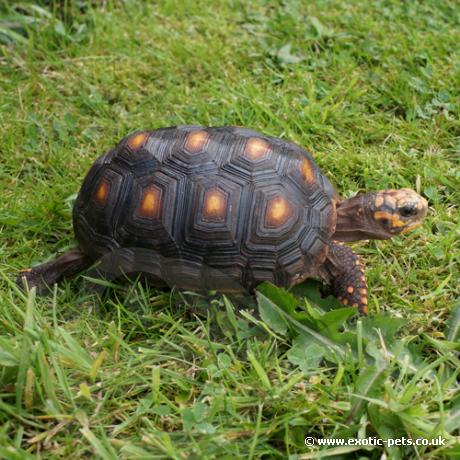

Red Foot Tortoise are medium sized tropical species from Northern South America. They have red scales present on the legs and head.
| Origin | Northern South America |
|---|---|
| Environment | Tropical rainforests |
| Adult Size | Up to 40cm |
| Suitability | Intermediate |
| Lifespan | 50 years plus |
| Temperament | Docile |
Red-Footed tortoises are medium in size averaging around 30-40cm (12-16 inches) in length. Red-Foots have a loaf shaped carapace which is quite variable in colour depending on which region they are from; as a rule they have a dark overall appearance but with lighter patching in the middle of each scute. Some specimens have intense red scales to a pale yellow on their legs and head. Males are the larger of the two sexes with a concave plastron; they also have a narrower mid-section giving them the appearance of a waist.
These tortoises are very closely related to the Yellow-Footed Tortoise from the Amazon basin.
These tortoises are normally found in Northern South America. Their natural habitats can be anything from grasslands, to the forest-edges around the amazon basin. They are also found within tropical rainforests of South America. There are known populations found on some of the Carribean islands.
Unlike more arid species like Hermanns and Horsfields which need open top Tortoise Tables, Red-Footed tortoises are best kept in large vivarium as it is easier to control temperatures and humidity levels. Housing your Red-Foot tortoise in a vivarium such as the Vivexotic AAL is advisable, however you may need a larger custom built vivarium as your animal grows in the future. Although they may live perfectly happily in this size vivarium, the more space you provide them with the better it will be for your tortoise.
Red-Footed tortoises come from tropical regions and therefore require a higher level of humidity. The enclosure must be kept at a higher humidity of around 70-85% we would recommend spraying the enclosure to try and maintain optimal humidity. For substrate we would recommend a mixture of a soil based tortoise bedding with Orchid bark and Coco husk mixed in. Its texture and moisture retention replicates their environment perfectly.
You will need to aim to reach a daytime basking spot temperature of around 30°C (86F) and around 24-26°C (75-79F) on the cool end of the enclosure. The use of a 5% UVB bulb is also required to help with growth of the shell and bone development.
Décor is generally a personal choice, but don’t forget that tortoises need items such as shallow cork bark or rocks to climb over to keep them active, healthy and mentally stimulated.
It is very important to choose the correct sized feeding and water dishes for your animal and we feel the ProRep Tortoise Pools to be best for young and adult tortoises alike. They are much shallower and allow the tortoises to reach their food or go for a soak with more ease than some of the alternative products on the market. We use these products within our own enclosures at Exotic-Pets!
Red-Footed tortoises are actually omnivorous; they much prefer fruits, greens and vegetables to grasses. They also occasionally will have other high protein food such as worms and rodents. DO NOT feed iceberg lettuce or any other head lettuces as they contain very little vitamin and minerals. Please remember variety is very important to keep your animal healthy, you should aim to provide a diet of around 70% fruit, 25% greens, 5% protein based diet. Here is a list of recommended supermarket obtainable products to feed your tortoise.
Fruits:
Greens/Vegetables:
For a full list of Reptile Safe Edible Plants CLICK HERE
Protein:
It is very important that you supplement the diet of your tortoise with calcium and multivitamin supplements. You can simply sprinkle this over the top of the food you provide your tortoise. This is very beneficial to all reptiles and prevents any horrific problems occurring such as metabolic bone disease.
Many species of tortoise that are available today are subject to CITES (Convention on International Trade in Endangered Species) article 10 paperwork. This in a nutshell provides a certificate/microchip to prove that these tortoises are captive farmed/captive bred and have not been illegally taken from the wild. This paperwork/microchip is essential if you intend to sell or even breed your tortoise. Tortoise species covered under this act are known as Annex A. Red-Footed tortoises however are not covered under this act and require no CITES paperwork. We would still recommend that you buy your tortoise from a reliable reptile shop to ensure that you will get a healthy captive farmed/captive bred tortoise.